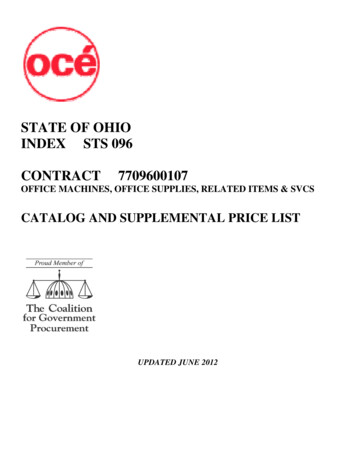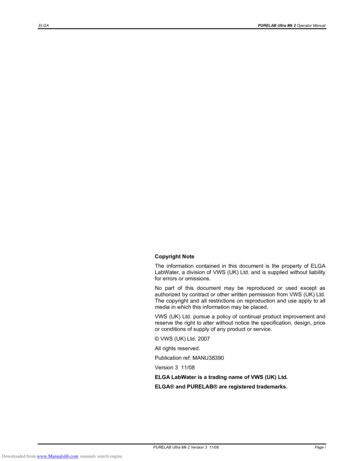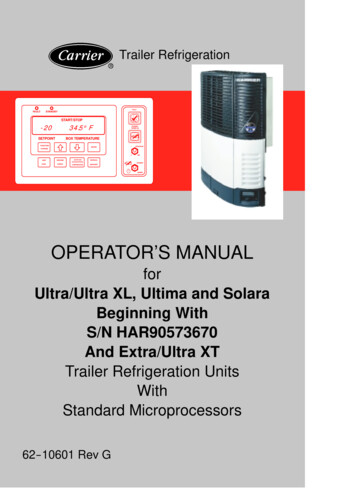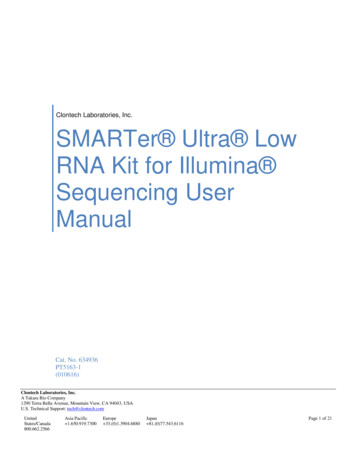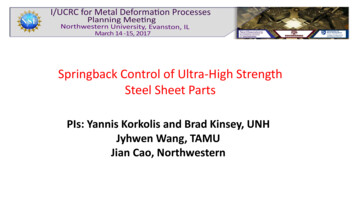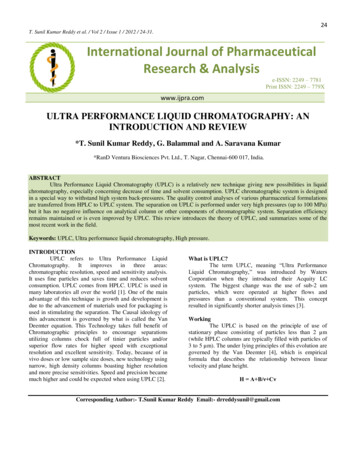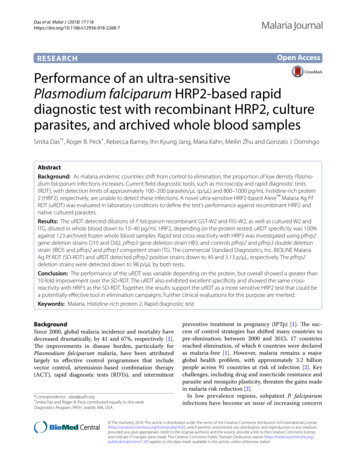
Transcription
Das et al. Malar J (2018) aria JournalOpen AccessRESEARCHPerformance of an ultra‑sensitivePlasmodium falciparum HRP2‑based rapiddiagnostic test with recombinant HRP2, cultureparasites, and archived whole blood samplesSmita Das*†, Roger B. Peck†, Rebecca Barney, Ihn Kyung Jang, Maria Kahn, Meilin Zhu and Gonzalo J. DomingoAbstractBackground: As malaria endemic countries shift from control to elimination, the proportion of low density Plasmodium falciparum infections increases. Current field diagnostic tools, such as microscopy and rapid diagnostic tests(RDT), with detection limits of approximately 100–200 parasites/µL (p/µL) and 800–1000 pg/mL histidine-rich protein2 (HRP2), respectively, are unable to detect these infections. A novel ultra-sensitive HRP2-based Alere Malaria Ag P.fRDT (uRDT) was evaluated in laboratory conditions to define the test’s performance against recombinant HRP2 andnative cultured parasites.Results: The uRDT detected dilutions of P. falciparum recombinant GST-W2 and FliS-W2, as well as cultured W2 andITG, diluted in whole blood down to 10–40 pg/mL HRP2, depending on the protein tested. uRDT specificity was 100%against 123 archived frozen whole blood samples. Rapid test cross-reactivity with HRP3 was investigated using pfhrp2gene deletion strains D10 and Dd2, pfhrp3 gene deletion strain HB3, and controls pfhrp2 and pfhrp3 double deletionstrain 3BD5 and pfhrp2 and pfhrp3 competent strain ITG. The commercial Standard Diagnostics, Inc. BIOLINE MalariaAg P.f RDT (SD-RDT) and uRDT detected pfhrp2 positive strains down to 49 and 3.13 p/µL, respectively. The pfhrp2deletion strains were detected down to 98 p/µL by both tests.Conclusion: The performance of the uRDT was variable depending on the protein, but overall showed a greater than10-fold improvement over the SD-RDT. The uRDT also exhibited excellent specificity and showed the same crossreactivity with HRP3 as the SD-RDT. Together, the results support the uRDT as a more sensitive HRP2 test that could bea potentially effective tool in elimination campaigns. Further clinical evaluations for this purpose are merited.Keywords: Malaria, Histidine-rich protein 2, Rapid diagnostic testBackgroundSince 2000, global malaria incidence and mortality havedecreased dramatically, by 41 and 67%, respectively [1].The improvements in disease burden, particularly forPlasmodium falciparum malaria, have been attributedlargely to effective control programmes that includevector control, artemisinin-based combination therapy(ACT), rapid diagnostic tests (RDTs), and intermittent*Correspondence: sdas@path.org†Smita Das and Roger B. Peck contributed equally to this workDiagnostics Program, PATH, Seattle, WA, USApreventive treatment in pregnancy (IPTp) [1]. The success of control strategies has shifted many countries topre-elimination; between 2000 and 2015, 17 countriesreached elimination, of which 6 countries were declaredas malaria-free [1]. However, malaria remains a majorglobal health problem, with approximately 3.2 billionpeople across 91 countries at risk of infection [2]. Keychallenges, including drug and insecticide resistance andparasite and mosquito plasticity, threaten the gains madein malaria risk reduction [2].In low prevalence regions, subpatent P. falciparuminfections have become an issue of increasing concern The Author(s) 2018. This article is distributed under the terms of the Creative Commons Attribution 4.0 International License(http://creat iveco mmons .org/licen ses/by/4.0/), which permits unrestricted use, distribution, and reproduction in any medium,provided you give appropriate credit to the original author(s) and the source, provide a link to the Creative Commons license,and indicate if changes were made. The Creative Commons Public Domain Dedication waiver (http://creat iveco mmons .org/publi cdoma in/zero/1.0/) applies to the data made available in this article, unless otherwise stated.
Das et al. Malar J (2018) 17:118[2–6]. These subpatent carriers have been estimated tocontribute to 20–50% of human-to-mosquito transmission, emphasizing the role of this reservoir populationin continued transmission [6]. Furthermore, a majority of these parasite carriers have infections undetectable by microscopy and RDT, both of which havesimilar detection limits in terms of parasites per µL(p/µL), at approximately 100–200 p/µL [5, 7–10]. Thepoor performance of commercially available RDTs interms of sensitivity for low density parasite infectionslimits their utility in elimination strategies. In manysettings, molecular nucleic acid–based tests becomethe most reliable tests for understanding the levels ofinfection in a population [7, 8, 11, 12]. While nucleicacid-based testing affords the benefits of sensitivity, itis costly and often challenging to implement both fromtechnical and logistical perspectives for many malariaprogrammes.Modelling of mass screen-and-treat strategies suggests that a RDT with limits-of-detection (LOD) onthe order of 2–20 p/μL expands the entomologicalinoculation rate (EIR) at which transmission could beinterrupted from less than 1–4 [6]. Likewise, a moresensitive RDT could be used to trigger mass drugadministration (MDA), as long as its ability to predictmalaria prevalence approximates that of nucleic acidtests [6]. A diagnostic test for malaria with a 10- or100-fold improvement in limit of detection (LOD) overmicroscopy or current RDTs that is simple to use andcan be used at the point-of-care could be a useful toolfor elimination strategies. RDTs targeting the P. falciparum-specific antigen histidine-rich protein 2 (HRP2)remain the most sensitive and robust tests for diagnosisof P. falciparum malaria, in part due to poorer LODsof tests for the other commonly used antigen, lactatePage 2 of 7dehydrogenase (LDH), as well as HRP2 accumulationduring infection [13].A novel ultra-sensitive Alere Malaria Ag P.f RDT(uRDT) has been recently developed. The uRDT takesadvantage of the immunochromatographic cassetteplatform, whole blood volume requirements (5 µL),and slightly longer time to results as the current Standard Diagnostics, Inc. BIOLINE Malaria Ag P.f RDT(SD-RDT) Because the general test format of the uRDTis similar to the SD-RDT and most field teams are wellversed in performing the SD-RDT, the uRDT fulfillsmany of the assured criteria and is additionally portable,stable, and functional in resource-limited areas [10, 14].In this study, the uRDT detection threshold and testperformance were investigated using different P. falciparum HRP2 types and parasite culture strains.MethodsRapid diagnostic tests (RDTs)All whole blood specimens were tested for P. falciparumusing the commercially available Standard DiagnosticsInc. BIOLINE Malaria Ag P.f RDT (SD-RDT) (Reference number: 05FK50, Test lot number: 05CDA051A,Sub: A, Diluent lot number: 05BDDA102, Manufacturedate: 2015.08.23, Expiry date: 2017.08.22; Republic ofKorea) and Alere Malaria Ag P.f RDT (uRDT) (Reference number: 05FK140, Test lot number: 05LDB001A,Sub: A, Diluent lot number: 05BDDA145, Manufacturedate: 2015.02.25, Expiry date: 2017.02.25; Republic ofKorea). The uRDT, like the SD-RDT, is an immunochromatographic membrane strip test, but differs in that ituses biotinylated and carboxyl-modified latex fragmentantibodies (FAbs) and polystreptavidin bound to thetest line to detect P. falciparum-specific HRP2 in wholeblood. The workflow of the uRDT is comparable to thatof the RDT (Fig. 1). The test requires 5 µL of whole bloodFig. 1 uRDT work flow. (1) 5 μL of sample is collected and (2) delivered to the sample well in the test cassette, followed by (3) the addition of fourdrops of assay buffer. (4) The test is allowed to incubate and the uRDT results are interpreted after 20 min while the SD-RDT results are interpretedafter 15 min. The presence of a line of any intensity is considered for interpretation. (5) Tests with only a control line are interpreted as negative. (6)Tests with both control and test lines are interpreted as positive. (7) The absence of a control line indicates the test is invalid and should be repeated
Das et al. Malar J (2018) 17:118specimen. The blood is applied to the sample port in thetest followed by application of 4 drops of assay diluent.Twenty minutes after application of the specimen, theresult is interpreted from the result window. A positivecontrol line (red) with a positive test line (blue/black) isinterpreted as a positive result, and a positive control lineand negative test line is interpreted as a negative result.Any test without a signal on the control line is consideredan invalid test.BenchmarkingBenchmark testing was performed to define the testLOD for HRP2. Two P. falciparum HRP2 recombinantproteins, GST-W2 (rGST-W2) (Microcoat Biotechnologie GmbH, Bernried am Starnberger See, Germany) andFliS-W2 (rFliS-W2) (Alere , San Diego, California), andtwo P. falciparum culture strains, W2 (ZeptoMetrix Corporation, Buffalo, New York) and ITG (BEI Resources,Manassas, Virginia), were selected for testing. All HRP2types were stored at 80 C and thawed on ice duringtesting. The rGST-W2 and rFliS-W2 proteins were bothsupplied at 100 µg/mL. Each recombinant protein wasdiluted in negative whole blood (Interstate Blood Bank,Inc., Memphis, Tennessee; K3-EDTA anticoagulant) to500 and 250 pg/mL, and tested with the Malaria Antigen(HRP2) CELISA (Catalog number: KM2, batch number:KM269; Cellabs, Sydney, NSW, Australia). Concentrations calculated with CELISA approximated the respective concentrations (rGST-W2: 518 and 219 pg/mL;rFliS-W2: 492 and 240 pg/mL). Subsequent dilutions ofrecombinant protein were prepared using the reportedconcentration from the stock protein.For the P. falciparum native proteins, W2 culture wasprovided in prepared aliquots with reported HRP2 concentrations of 800 and 253 pg/mL. These concentrationsand an additional dilution of the 800 pg/mL concentration in negative whole blood to 250 pg/mL were testedwith CELISA. Concentrations calculated with CELISAwere 588, 104 and 172 pg/mL, respectively. Subsequentdilutions of W2 culture were prepared using the concentrations calculated from CELISA. ITG was cultured intype O human erythrocytes diluted at 4% hematocritin RPMI-1640 media (KD Medical, Columbia, Maryland) supplemented with 25 mM HEPES (Gibco, Gaithersburg, Maryland), sodium bicarbonate (Sigma-Aldrich,St. Louis, Missouri), hypoxanthine (Sigma-Aldrich), gentamycin (Sigma-Aldrich), and 10% heat-treated humanO serum (Interstate Blood Bank, Inc.) as describedpreviously [15]. Parasite cultures were synchronizedwith 5% d-sorbitol (Sigma-Aldrich) two times prior toharvesting at ring stage ( 99%), and the parasitaemiaof the entire culture without fractionation was determined by microscopic analysis. Native culture materialPage 3 of 7was frozen for long-term storage at 80 C and usedfor preparing serial dilutions into uninfected fresh blood(PlasmaLab International, Everett, Washington). TheITG culture stock was reported to have a concentrationof 10.2 ng/mL HRP2, diluted in negative whole blood to500 and 250 pg/mL HRP2, and tested with the CELISA.The CELISA approximated the concentrations 577 and251 pg/mL HRP2, respectively. Subsequent ITG culturedilutions were prepared using the reported concentrationfrom the stock.Each sample (GST-W2, FliS-W2, cultured W2, andcultured ITG) was diluted with negative whole blood toyield six serial dilutions representing HRP2 concentrations of 250, 125, 80, 40, 20, and 10 pg/mL. Each sampleconcentration and the negative diluent was tested withthe uRDT in five replicate by highly skilled operators ina controlled laboratory setting at PATH (Seattle, Washington). Expanded testing (75 additional replicates) wasconducted for each sample near the LOD, based on thelowest concentration that was repeat reactive (at least 2of 5 replicates), along with the concentration immediatelyabove and below the lowest repeat reactive concentration. The final sample size of 80 was based on a statistical sampling plan (ISO 2859-1:1999). General inspectionlevel I was selected and Sample size code J was determined by lot size (3201–10,000); Single sampling plan fornormal inspection was selected, which determined thesample size of 80.SpecificitySpecificity testing was conducted with archived frozenwhole blood from 123 unique donors from malaria nonendemic settings (BioreclamationIVT, Hicksville, NewYork). Venipuncture NaEDTA whole blood was collectedfrom 11 additional donors from malaria non-endemicsettings (PlasmaLab International, Everett, Washington) for comparing the test with matched fresh versusfrozen venipuncture whole blood samples. Each samplefor specificity testing was conducted in duplicate withthe uRDT according to the manufacturer’s instructionsby highly skilled operators at PATH. Assay diluent only(no sample) was tested in duplicate. All tests with thespecificity samples were interpreted at the recommended20 min read time and at 1 h.Plasmodium falciparum culture strains with pfhrp2and pfhrp3 gene deletionsFour P. falciparum strains with pfhrp gene deletions wereselected for evaluation with the uRDT. Strains D10 (BEIResources, Manassas, Virginia) and Dd2 (BEI Resources,Manassas, Virginia) were selected for their pfhrp2 genedeletion, but presence of pfhrp3 gene. Strain HB3 (USCenters for Disease Control and Prevention [CDC],
Das et al. Malar J (2018) 17:118Page 4 of 7Atlanta, Georgia) was selected for the presence of pfhrp2gene, but deletion of pfhrp3 gene. Strain 3BD5 (NationalInstitute of Allergy and Infectious Diseases [NIAID],Bethesda, Maryland) was selected for the absence of bothpfhrp2 and pfhrp3 genes. The ITG strain was chosen forthe presence of both pfhrp2 and pfhrp3. D10, Dd2, andHB3 were cultured according to the ITG culture methodpreviously described [15]. The P. falciparum 3BD5 strainwas cultured as described previously [16] with minormodifications to the complete media composition: 0.22%sodium bicarbonate, 20 mg/L gentamicin, 55.56 µg/Lhypoxanthine, and 27.7 mM HEPES. Additionally, thecultures were maintained at 3% hematocrit between 1and 4% parasitaemia in complete media, and O erythrocytes (PlasmaLab International, Everett, Washington)were washed 3 times with PBS to remove leukocytesand platelets. The 3BD5 culture was synchronized twicewith 5% d-sorbitol (Sigma-Aldrich) prior to harvestingat ring stage ( 99%), and parasitaemia was determinedby microscopy. The cultures of the four aforementionedpfhrp gene deletion strains and also previously describedITG (a P. falciparum strain with both pfhrp2 and pfhrp3genes) were serially diluted 2-fold in whole blood from195 to 1.56 p/µL. Each dilution of each strain was testedin duplicate with uRDT and SD-RDT according to themanufacturer’s instructions by highly skilled operators atPATH.Statistical analysisuRDT specificities against frozen archived whole bloodsamples from malaria negative blood donors in nonendemic settings at the 20 min and 1 h time pointswere calculated by 100 * [(true negatives)/(true negatives false positives)].ResultsAnalytical sensitivityBenchmarking results showed slight differences in testperformance among the HRP2 protein types tested. Asthe HRP2 was diluted and the test LOD was approached,the test lines for each of the samples and dilutionsdecreased in intensity. Initial testing to determine thelowest concentration with repeat reactivity resultedin rGST-W2 at 80 pg/mL (3/5), rFliS-W2 at 20 pg/mL(3/5), cultured W2 at 20 pg/mL (2/5), and cultured ITGat 40 pg/mL (2/5) (Table 1). Expanded testing was thenconducted and showed that the uRDT meets the AQLacceptance criteria for rGST-W2 at 125 pg/mL, rFliS-W2and cultured W2 at 40 pg/mL, and cultured ITG at 80 pg/mL (Table 1).Time‑to‑results and specificity testinguRDT specificity was 100% at 20 min with the panel of123 archived frozen whole blood samples from unexposed blood donors from a non-endemic geographicarea. At 1 h, the uRDT specificity decreased to 43.1%.No difference in test results was observed in comparingthe matched fresh and frozen venipuncture whole blood(Table 2). One test for each condition gave a reactiveresult at the read time of 20 min, resulting in a specificity of 95.5% (Table 2). The duplicate test of each reactiveresult was nonreactive. Testing with buffer only yieldednon-reactive test results, showing control lines but notest lines (Table 2). Interpreting the tests at 1 h increasedthe number of observed reactive results and uninterpretable results due to hemolysis obscuring the test line(Table 2). Excluding the uninterpretable results, the specificities of fresh and frozen venipuncture whole blood at1 h were 29.4% (5/17) and 57.1% (12/21), respectively.Cross reactivity with HRP3A total of five P. falciparum strains were run on the rapidtests representing different combinations of the presenceof pfhrp2 and pfhrp3 genes: ITG (pfhrp2 , pfhrp3 ), HB3(pfhrp2 , pfhrp3 ), D10 and Dd2 (pfhrp2 , pfhrp3 ), and3BD5 (pfhrp2 , pfhrp3 ). All tests yielded valid results.Strains with the pfhrp2 gene, independent of the presence of the pfhrp3 gene (ITG and HB3) reacted similarlywith both rapid tests, detecting down to 49 p/µL with theSD-RDT and 3.13 p/µL with the uRDT (Table 3). BothTable 1 uRDT analytical sensitivity with two recombinant HRP2 proteins and two native culture HRP2 proteinsTarget conc. (pg/mL)rGST-W2 (%)rFliS-W2 (%)Cultured W2 (%)Cultured ITG (%)2505/5 (100)5/5 (100)5/5 (100)12579/80 (98.8)5/5 (100)5/5 (100)5/5 (100)8065/80 (81.3)5/5 (100)5/5 (100)79/80 (98.8)4022/80 (27.5)78/80 (97.5)77/80 (96.3)40/80 (50.0)201/5 (20.0)51/80 (63.8)47/80 (58.8)9/80 (11.3)100/5 (0)9/80 (11.3)9/80 (11.3)00/5 (0)0/5 (0)0/5 (0)5/5 (100)0/5 (0)0/5 (0)
Das et al. Malar J (2018) 17:118Page 5 of 7Table 2 uRDT time-to-results and specificity testing resultsSample typeResults (20 min)Results (1 h)Archived frozen whole blood (n 123 in duplicate)0 Reactive140 Reactive246 Non-reactive106 Non-reactiveMatched fresh venipuncture whole blood (n 11 in duplicate)1 Reactive21 Non-reactive12 Reactive5 Non-reactive5 UninterpretableMatched frozen venipuncture whole blood (n 11 in duplicate)1 Reactive21 Non-reactive9 Reactive12 Non-reactive1 UninterpretableBuffer (n 2)0 Reactive1 Reactive2 Non-reactive1 Non-reactiveTable 3 SD-RDT and uRDT performance against different P. falciparum malaria strainsITG (pfhrp2 , pfhrp3 )D10 (pfhrp2 , pfhrp3 ) Dd2 (pfhrp2 , pfhrp3 ) HB3 (pfhrp2 , pfhrp3 ) 3BD5 (pfhrp2 ,pfhrp3 NRNRNRNR0NRNRNRNRNRNRNRNRNRNRP. falciparumparasitaemia (p/µL)R reactive specimen, NR non-reactive specimenstrains with pfhrp2 gene deletions only (D10 and Dd2)reacted similarly with both rapid tests, detecting down to98 p/µL (Table 3). The 3BD5 strain with both pfhrp2 andpfhrp3 deletions was undetectable by both SD-RDT anduRDT at all parasitaemias (Table 3).DiscussionThe shift from high to low P. falciparum transmission inmany endemic areas has revealed a considerable presence of asymptomatic infections that are undetectableby current field methods [2, 3, 6, 12, 17, 18]. As a result,there is a need for a more sensitive field-based diagnostic test to detect the subpatent reservoir of transmission and support effective elimination programmes [2,6]. In this study, the analytical performance of a noveluRDT against recombinant and native HRP2 strains andarchived clinical whole blood specimens was evaluated ina laboratory setting.Evaluation of the uRDT with recombinant and cultured proteins from multiple sources according to astatistically significant sample size provides an indepth characterization of test performance and a betterdescription of test-to-test variability. The variabilityin detecting different sources of HRP2 (recombinant,culture, and different culture strains) could be due toseveral factors. These factors could include protein variation (e.g., number of epitope repeats), affinity of theantigen-binding fragment in the RDT for different variants of HRP2, variations in actual protein present in thesample based on the starting concentration and dilutionrequired, and degradation of the HRP2 protein due tohandling and storage [19, 20]. The LODs for rGST-W2and rFliS-W2 HRP2 in uRDT were 125 and 40 pg/mLrespectively. Similarly, the LODs for cultured P. falciparum W2 and ITG were 40 and 80 pg/mL HRP2 respectively, but the extent of cross-reaction by HRP3 was notexplored. Across different P. falciparum malaria strains,the uRDT was positive as low as 3.13 p/µL, but it isimportant to note that there can be significant variationin HRP2 concentrations and parasitaemia in both laboratory and field conditions, and that the data reportedhere reflect analytical performance only. Overall, theseresults are reflective of those also observed when running the uRDT on clinical specimens as previously
Das et al. Malar J (2018) 17:118described [21]. This represents an approximate 10-foldlower limit of detection than current best-in-classRDTs, which have an approximate limit of detection forHRP2 of 800–1000 pg/mL [22].The uRDT exhibited excellent specificity againstarchived P. falciparum negative whole blood specimensfrom donors in non-endemic areas. However, there werea number of false reactive and uninterpretable results at1 h, indicating that it is critical for the tests to be interpreted at 20 min as described in the product instructions.Additionally, in the field, individuals who are parasite negative, but HRP2 positive due to persistence aredetectable by commercial RDTs [23], making it essentialto assess uRDT performance in endemic areas. Recently,the uRDT was tested using whole blood specimens fromasymptomatic study participants in Myanmar, a lowtransmission area with parasitaemia and HRP2 rangingfrom 0.2 to 136.9 p/µL and 31.2 to 265.6 pg/mL, respectively, and Uganda, a high transmission area with parasitaemia and HRP2 ranging from 0.01 to 235,095 p/µL and6.1 to 14.600 pg/mL, respectively [21]. When comparedto qRT-PCR reference assay results, uRDT sensitivitieswere 44% in Myanmar and 84% in Uganda. The specificities were 99.8 and 92%, respectively, for the same twosites. In comparison, by SD-RDT, the sensitivities were0% in Myanmar and 62% in Uganda, and the specificitieswere 100% and 95%, respectively. The results suggest thatin different transmission settings, where parasitaemiasand HRP2 distributions vary, the improvement in detection of asymptomatic infections by uRDT versus SDRDT is inconsistent. Also, a limitation of both this studyand the recently published evaluation with clinical specimens from Myanmar and Uganda is that the uRDTs wererun in laboratory conditions with expert readers, whichcharacterized baseline performance, but does not necessarily depict performance under field conditions. Thus,additional uRDT studies should be conducted in the fieldto further define performance.In a limited evaluation of the uRDT and SD-RDT usingdifferent P. falciparum pfhrp2 and/or pfhrp3 gene deletion culture strains, the uRDT showed at least a 10-foldlower parasitaemia LOD than the SD-RDT. Additionally, both the uRDT and SD-RDT appear to have thesame threshold cross-reactivity with HRP3, which hasbeen previously reported with different HRP2-specificmonoclonal antibodies and distinct parasite isolates [20].Future studies should include evaluation of the uRDTin areas with P. falciparum pfhrp2 and/or pfhrp3 genedeletions.Page 6 of 7ConclusionsThe evidence from this evaluation of the uRDT indicates that it is more sensitive than a currently available malaria HRP2 rapid test. Because the uRDT hasthe same form-factor and usability features as currentRDTs, it can be easily adopted in low resource settingsand detect a higher proportion of people with low density P. falciparum infections. This may help identifyactive case detection strategies that will successfullyreduce the parasite reservoir. Accordingly, future studies should perform uRDT testing in malaria endemicareas. Concerns about overtreatment, incorrect diagnosis of febrile patients, and increased burden tomalaria control programmes due to identification ofmore malaria cases may be valid. Further research isalso needed to better understand how a more sensitivetest can be implemented appropriately in a manner thatis cost-effective. This initial evidence suggests that theuRDT may be an effective new tool for malaria controland elimination programmes.AbbreviationsACT : artemisinin-based combination therapy; EIR: entomological inoculationrate; FAb: fragment antibody; HRP2: histidine-rich protein 2; IPTp: intermittentpreventive treatment in pregnancy; LDH: lactate dehydrogenase; LOD: limitof detection; MDA: mass drug administration; p/µL: parasites per microlitre;pfhrp2: Plasmodium falciparum histidine-rich protein 2 gene; pfhrp3: Plasmodium falciparum histidine-rich protein 3 gene; pg/mL: picogram per milliliter;RDT: rapid diagnostic test; SD-RDT: Standard Diagnostics, Inc. BIOLINE MalariaAg P.f RDT; uRDT: ultra-sensitive Alere Malaria Ag P.f RDT.Authors’ contributionsSD, RP, and GD conceived and designed the study. IKJ and RB obtained theP. falciparum recombinant GST-W2 HRP2, FliS-W2 HRP2, and native cultureD10, Dd2, and HB3 strains. RB cultured the P. falciparum 3BD5 and ITG strains.SD and RB performed the analytical evaluations and specificity testing ofthe uRDT in the laboratory. MK and MZ performed the HRP3 cross-reactivityexperiments with the uRDT and SD-RDT. SD was responsible for data management and analysis. SD and RP prepared the manuscript. GD and RP providedoverall supervision of the study and preparation of the manuscript. All authorsread and approved the final manuscript.AcknowledgementsThe authors would like to thank Dr. Sanjay Kumar at the Centers for DiseaseControl and Prevention for providing the P. falciparum native culture D10, Dd2,and HB3 strains. We also acknowledge Dr. Thomas Wellems at the NationalInstitute of Allergy and Infectious Diseases for providing the P. falciparumnative culture 3BD5 strain.Competing interestsThe authors declare that they have no competing interests.Availability of data and materialsThe datasets used and analysed during the current study are available fromthe corresponding author upon reasonable request.Consent for publicationNot applicable.Ethics approval and consent to participateFor the human donor whole blood specimens, BioreclamationIVT and PlasmaLab International obtained written consent from all individuals. All samples
Das et al. Malar J (2018) 17:118were decoded and de-identified before they were provided for researchpurposes.FundingThis work was supported by a grant from the Bill & Melinda Gates Foundation,OPP1053616. Meilin Zhu was supported by the Siemens Foundation PATHFellowship, OPP-00006234.Publisher’s NoteSpringer Nature remains neutral with regard to jurisdictional claims in published maps and institutional affiliations.Received: 13 October 2017 Accepted: 9 March 2018References1. WHO. World malaria report 2016. Geneva: World Health Organization;2016.2. Hemingway J, Shretta R, Wells TNC, Bell D, Djimdé AA, Achee N, et al. Toolsand strategies for malaria control and elimination: what do we need toachieve a grand convergence in malaria? PLoS Biol. 2016;14:e1002380.3. Greenwood B. Asymptomatic malaria infections–do they matter? Parasitol Today. 1987;3:206–14.4. Okell LC, Bousema T, Griffin JT, Ouedraogo AL, Ghani AC, Drakeley CJ.Factors determining the occurrence of submicroscopic malaria infectionsand their relevance for control. Nat Commun. 2012;3:1237.5. Okell LC, Ghani AC, Lyons E, Drakeley CJ. Submicroscopic infection inPlasmodium falciparum-endemic populations: a systematic review andmeta-analysis. J Infect Dis. 2009;200:1509–17.6. Slater HC, Ross A, Ouedraogo AL, White LJ, Nguon C, Walker PGT,et al. Assessing the impact of next-generation rapid diagnostic testson Plasmodium falciparum malaria elimination strategies. Nature.2015;528:S94–101.7. Adams M, Joshi SN, Mbambo G, Mu AZ, Roemmich SM, Shrestha B,et al. An ultrasensitive reverse transcription polymerase chain reactionassay to detect asymptomatic low-density Plasmodium falciparum andPlasmodium vivax infections in small volume blood samples. Malar J.2015;14:520.8. Bousema T, Okell L, Felger I, Drakeley C. Asymptomatic malaria infections:detectability, transmissibility and public health relevance. Nat Rev Microbiol. 2014;12:833–40.9. Laban NM, Kobayashi T, Hamapumbu H, Sullivan D, Mharakurwa S, ThumaPE, et al. Comparison of a PfHRP2-based rapid diagnostic test and PCR formalaria in a low prevalence setting in rural southern Zambia: implicationsfor elimination. Malar J. 2015;14:25.10. Mabey D, Peeling RW, Ustianowski A, Perkins MD. Tropical infectiousdiseases: diagnostics for the developing world. Nat Rev Microbiol.2004;2:231–40.Page 7 of 711. Harris I, Sharrock WW, Bain LM, Gray KA, Bobogare A, Boaz L, et al. Alarge proportion of asymptomatic Plasmodium infections with low andsub-microscopic parasite densities in the low transmission setting ofTemotu Province, Solomon Islands: challenges for malaria diagnostics inan elimination setting. Malar J. 2010;9:254.12. Parker DM, Landier J, von Seidlein L, Dondorp A, White L, Hanboonkunupakarn B, et al. Limitations of malaria reactive case detection in an area oflow and unstable transmission on the Myanmar–Thailand border. Malar J.2016;15:571.13. Gatton ML, Rees-Channer RR, Glenn J, Barnwell JW, Cheng Q, Chiodini PL,et al. Pan-Plasmodium band sensitivity for Plasmodium falciparum detection in combination malaria rapid diagnostic tests and implications forclinical management. Malar J. 2015;14:115.14. Ebels KB, Clerk C, Crudder H, McGray S, Magnuson K, Tietje K, et al. Incorporating user needs into product development for improved infectiondete
()espectively, are unable to detect these infections. A novel ultra-sensitive HRP2-based Alere Malaria Ag P.f RD(T)valuated in laboratory conditions to define the test's performance against recombinant HRP2 and native cultured parasites. R: The uRDT detected dilutions of P. falciparum recombinant GST-W2 and FliS-W2, as well as cultured .
